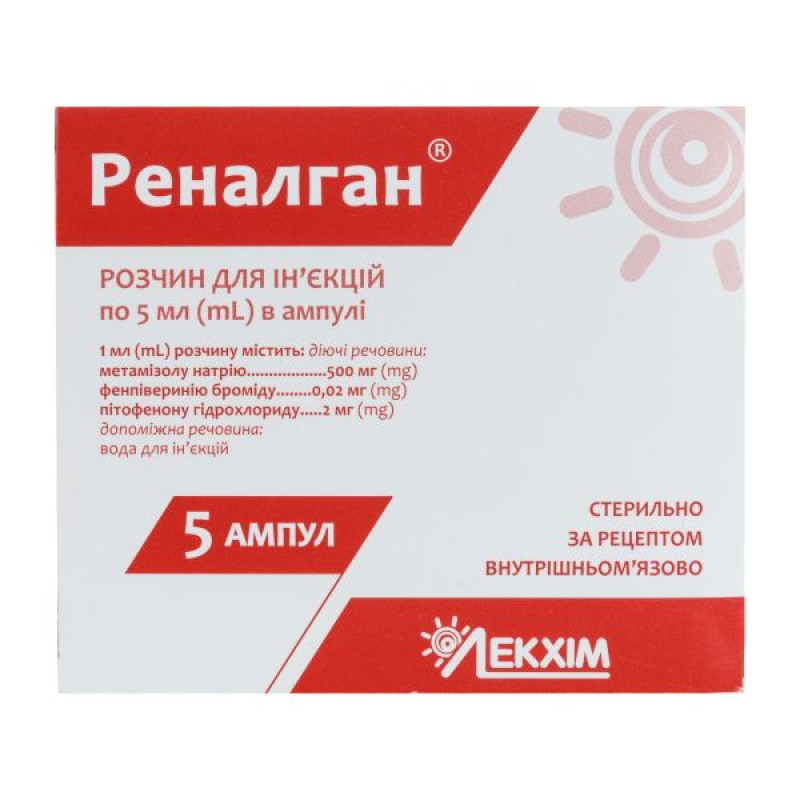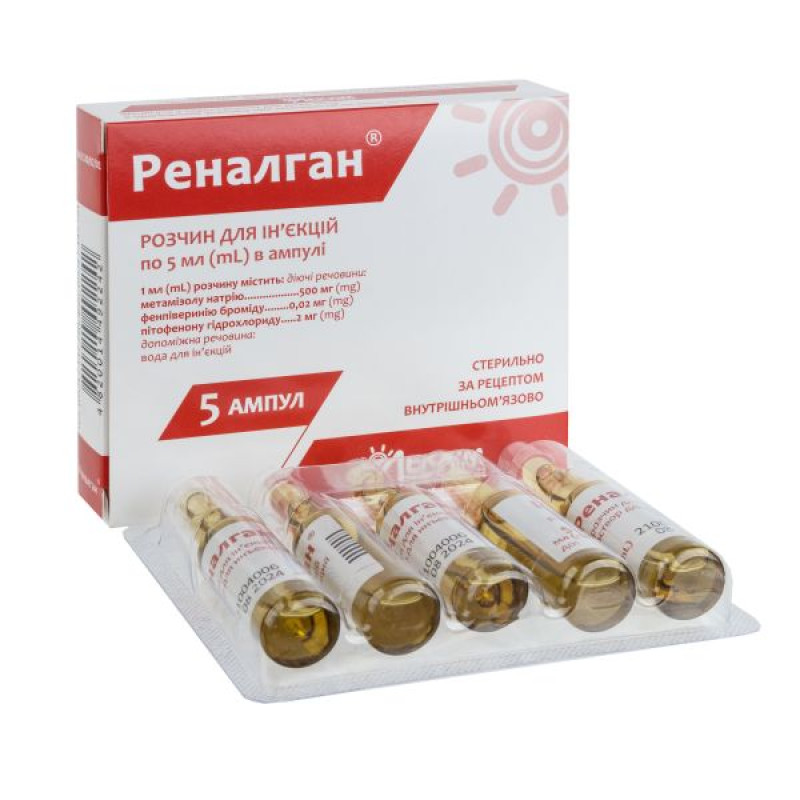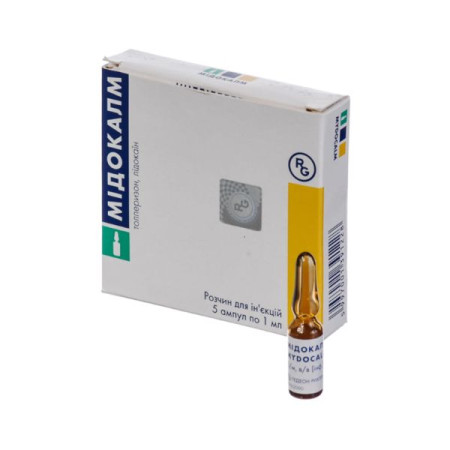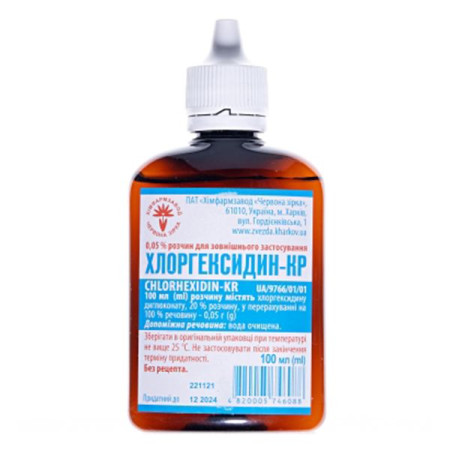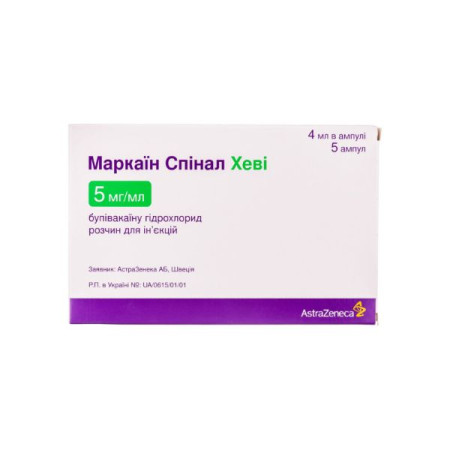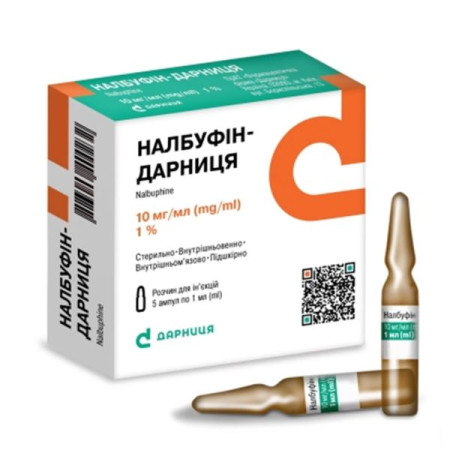Renalgan solution for injection ampoule 5 ml No. 5
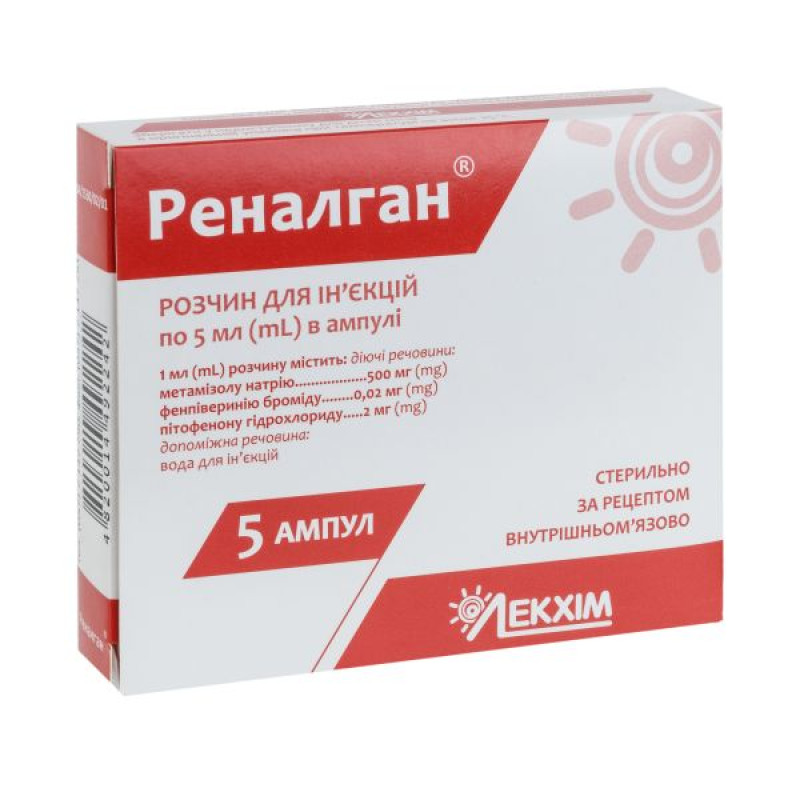
Instructions Renalgan solution for injection ampoule 5 ml No. 5
Composition
active ingredients: metamizole sodium, fenpiverinium bromide, pitophenone hydrochloride;
1 ml of solution contains metamizole sodium 500 mg; fenpiverinium bromide 0.02 mg; pitofenone hydrochloride 2 mg;
excipient: water for injections.
Dosage form
Solution for injection.
Main physicochemical properties: clear, light yellow liquid with a slightly greenish tint.
Pharmacotherapeutic group
Antispasmodics in combination with analgesics.
ATX code A03D A02.
Pharmacological properties
Pharmacodynamics.
Renalgan® is a combined drug that has analgesic and antispasmodic properties. The drug contains three active ingredients: the non-narcotic analgesic metamizole sodium (analgin), the myotropic antispasmodic pitofenone hydrochloride, and the anticholinergic fenpiverinium bromide. Metamizole is a derivative of pyralizole. It has analgesic, antipyretic, and weak anti-inflammatory effects. Pitofenone, like papaverine, has a direct myotropic effect on the smooth muscles of the internal organs and causes their relaxation. Fenpiverinium, due to its anticholinergic effect, has an additional antispasmodic effect on smooth muscles.
Pharmacokinetics.
When administered intramuscularly, it is rapidly absorbed. Metamizole has a systemic bioavailability of approximately 85%. Metamizole binds to plasma proteins by 50-60%. Penetrates the blood-brain and placental barriers. The volume of distribution is approximately 0.7 l/kg. Metamizole undergoes intensive biotransformation in the liver, and its main metabolites are pharmacologically active. Maximum plasma concentrations (for all metabolites) are established after approximately 30-90 minutes. It is excreted by the kidneys in the form of metabolites, with only 3% of the excreted amount of metamizole excreted unchanged. The half-life is approximately 10 hours.
Indication
Symptomatic treatment of pain syndrome in spasms of smooth muscles of internal organs:
gastric and intestinal colic;
renal colic in kidney stones;
spastic biliary dyskinesia;
dysmenorrhea.
Contraindication
Hypersensitivity to the components of the drug, to pyrazolone derivatives (butadione, tribuzone) or to other nonsteroidal anti-inflammatory drugs (NSAIDs). Severe hepatic or renal failure, acute hepatic porphyria, suspected surgical pathology, prostate adenoma of the II and III degree, congenital deficiency of glucose-6-phosphate dehydrogenase with a tendency to urinary retention, tachyarrhythmia, angle-closure glaucoma, gastrointestinal obstruction (including mechanical obstruction) and megacolon, atony of the gallbladder or bladder, diseases of the hematopoietic system (agranulocytosis, leukopenia, anemia of any etiology, including aplastic anemia, infectious neutropenia, hemolytic anemia), collaptoid conditions, decompensated heart failure, bronchial asthma, impaired bone marrow function (for example, after treatment with cytostatics), hypotonic conditions and hemodynamic instability.
Interaction with other medicinal products and other types of interactions
Combining the drug with other medications requires special caution due to the content of metamizole, which is an enzyme inducer.
When using the drug, alcohol consumption should be avoided, as there is a possibility of mutual potentiation of the effect.
The use of Renalgan® in combination with other non-narcotic analgesics may lead to mutual enhancement of side effects.
Tricyclic antidepressants (psychophorine, amitriptyline), oral contraceptives, allopurinol slow down the metabolism of metamizole in the liver, potentiate its effect when used simultaneously and increase its toxicity.
Enzyme inducers (barbiturates, phenylbutazone, glutethimide and other inducers of liver microsomal enzymes) weaken the effect of metamizole.
Sedatives and tranquilizers enhance the analgesic effect of Renalgan®.
When Renalgan® is administered simultaneously with quinine preparations, the anticholinergic effect may be enhanced.
Renalgan® reduces the concentration of cyclosporine in the blood plasma. If necessary, the combined use of the above and other drugs should be consulted with a doctor. Histamine H2-receptor antagonists, codeine and propranolol, when used simultaneously, enhance the effect of metamizole sodium.
Sarcolysin and mercazolil increase the risk of leukopenia.
Metamizole sodium increases the hypoglycemic activity of oral antidiabetic agents.
When used simultaneously, metamizole may reduce the activity of coumarin anticoagulants as a result of induction of liver enzymes.
With the simultaneous use of chlorpromazine and other phenothiazine derivatives with metamizole, there is a risk of severe hypothermia.
With the simultaneous use of chloramphenicol and other myelotoxic agents with metamizole, there is an increased risk of bone marrow suppression.
Concomitant use with other analgesics and NSAIDs increases the risk of hypersensitivity reactions and other adverse reactions.
Central nervous system depressants when combined with metamizole enhance its analgesic effect.
Renalgan® can be combined with hyoscine butylbromide, furosemide, and glibenclamide.
Radiocontrast agents, colloidal blood substitutes, and penicillin should not be used during treatment with metamizole.
Metamizole can induce metabolic enzymes, including CYP2B6 and CYP3A4.
Concomitant use of metamizole with bupropion, efavirenz, methadone, valproate, tacrolimus or sertaline may result in decreased plasma concentrations of these drugs with potential for reduced clinical efficacy. Therefore, caution is recommended when using these drugs concomitantly with metamizole; monitoring of clinical response and/or drug levels may be necessary.
The pyrazolone class of drugs is known to interact with captopril, lithium, methotrexate, and triamterene, and to alter the efficacy of antihypertensives and diuretics. The extent to which metamizole causes these interactions is unknown.
Application features
Renalgan® contains the drug metamizole, which carries a small but life-threatening risk of shock and agranulocytosis. The development of agranulocytosis is dose-dependent and unpredictable. It can develop after the first dose or after repeated administration. Typical signs of agranulocytosis are fever, sore throat, pain when swallowing, inflammation of the mucous membranes of the mouth, nose, pharynx, anorectal and genital areas. In case of sudden deterioration of the general condition and the appearance of signs of agranulocytosis, treatment with metamizole should be stopped immediately, without waiting for laboratory confirmation.
When treating with Renalgan®, there is a risk of developing anaphylactic reactions. At the first signs of hypersensitivity, the administration of the drug should be stopped immediately and urgent measures should be taken to relieve the condition (adrenaline, glucocorticoids, antihistamines).
The risk of hypersensitivity reactions (anaphylactoid reactions) when using metamizole is significantly increased in patients with:
food and drug hypersensitivity or atopic diseases (hay fever);
analgesic asthma syndrome or analgesic idiosyncrasy in the form of urticaria, angioedema, especially with concomitant rhinosinusitis and nasal polyps;
chronic urticaria;
idiosyncrasy to dyes (e.g., tartrazine), to preservatives (e.g., benzoates);
alcohol intolerance. Such patients react to the use of minimal amounts of alcoholic beverages with symptoms such as sneezing, tearing, and severe visual impairment. Such alcohol intolerance may be a sign of undiagnosed analgesic asthma syndrome.
Severe skin reactions
Severe skin reactions, including Stevens-Johnson syndrome, toxic epidermal necrolysis and drug reaction with eosinophilia and systemic symptoms (DRESS syndrome), which can be life-threatening or fatal, have been reported with metamizole treatment.
Patients should be informed about the signs and symptoms of skin reactions and monitored closely.
If symptoms suggestive of these reactions appear, metamizole treatment should be discontinued and under no circumstances should it be restarted (see section "Contraindications").
Drug-induced liver injury
Cases of hepatitis, mainly hepatocellular in nature, have been reported in patients taking metamizole, occurring within a few days to several months after initiation of treatment. Signs and symptoms include elevated serum liver enzymes, with or without jaundice, often in the setting of hypersensitivity reactions to other drugs (e.g. skin rash, blood dyscrasias, fever and eosinophilia) or accompanied by signs of autoimmune hepatitis. In most patients, the condition resolved after discontinuation of metamizole; however, isolated cases of progression to acute liver failure requiring liver transplantation have been reported.
The mechanism of liver damage caused by metamizole is not clearly understood, although available data suggest an immunoallergic mechanism.
Patients should be advised to seek medical advice if symptoms suggestive of liver damage occur. In such cases, metamizole should be discontinued and liver function should be assessed.
If symptoms such as feeling sick (nausea and vomiting), fever, feeling tired, loss of appetite, dark urine, light stool, yellowing of the skin or whites of the eyes, itching, rash, or upper abdominal pain occur, Renalgan® should be discontinued and a doctor should be consulted.
If the patient has previously had liver problems while taking any medication containing metamizole, the use of Renalgan® is not recommended.
The drug should be used with caution in patients receiving concomitant cytostatic drugs (only under the supervision of a physician).
Do not use to relieve acute abdominal pain.
When treating patients with hematological diseases, including a history of them, with Renalgan®, it is necessary to assess the risk/benefit ratio and monitor the hematological status during treatment.
In case of kidney and liver diseases, the dosage regimen should be selected individually due to possible side effects of metamizole on the kidneys and prolongation of the half-life of metamizole metabolites in case of impaired hepatocyte function.
The drug should be used with caution in patients with obstructive diseases of the digestive tract (achalasia, pyloroduodenal stenosis). Repeated use of Renalgan® in these cases may cause delayed elimination of gastrointestinal contents and intoxication. The use of Renalgan® in patients with gastroesophageal reflux disease, intestinal atony, inflammatory bowel diseases, including nonspecific ulcerative colitis and Crohn's disease, paralytic ileus, myasthenia gravis, heart diseases (arrhythmia, ischemic heart disease, congestive heart failure) requires special caution and monitoring by a doctor.
Use with caution in the treatment of patients with myocardial infarction, with severe arterial hypotension, as well as in the treatment of patients with systolic blood pressure lower than 100 mm Hg. Caution should be exercised when administering more than 2 ml of solution (risk of a sharp decrease in blood pressure).
Metamizole, which is included in the composition of the drug Renalgan®, can cause hypotonic reactions. These reactions are dose-dependent and are more often observed with parenteral administration. The risk of hypotonic reactions increases in the following cases:
in patients with pre-existing hypotension, volume and electrolyte depletion or dehydration, unstable hemodynamics or circulatory failure (e.g., in patients with myocardial infarction or polytrauma);
in patients with fever.
In such cases, careful assessment of the need for the drug and strict monitoring should be carried out. It may be necessary to take precautionary measures (e.g., stabilization of the circulatory system) to reduce the risk of arterial hypotension.
Renalgan® should only be used with careful monitoring of hemodynamic parameters in patients for whom lowering blood pressure is unacceptable, for example, in case of severe ischemic heart disease or significant stenosis of cerebral vessels.
Renalgan® should be used in patients with impaired renal function (including patients with a history of kidney disease (pyelonephritis, glomerulonephritis)) or liver function only after careful assessment of the benefit/risk ratio, taking appropriate precautions.
Do not exceed the recommended doses of the drug.
Use during pregnancy or breastfeeding
Do not use the drug during pregnancy or breastfeeding.
Ability to influence reaction speed when driving vehicles or other mechanisms
Due to the possibility of adverse reactions from the nervous system (dizziness, accommodation disorders), you should refrain from driving or working with other mechanisms that affect the speed of reaction.
Method of administration and doses
Renalgan®, solution for injection, should be administered intramuscularly only. Use only for short-term treatment.
The injection solution should be used under strict medical supervision due to the risk of anaphylactic shock in patients with hypersensitivity to metamizole or pyrazolone derivatives.
Adults and children aged 15 and over.
Adults and children over 15 years of age (with a body weight of more than 53 kg) should be administered intramuscularly from 2 to 5 ml of solution for injection. If necessary, repeat the dose after 6-8 hours. The maximum daily dose should not exceed 10 ml of solution for injection (equivalent to 5 g of metamizole sodium). Duration of treatment - 2-3 days. After achieving a therapeutic effect, you can switch to treatment with oral analgesics and antispasmodics. In the absence of a therapeutic effect, treatment with the drug should be discontinued.
Patients aged 65 and over.
Usually, no dose reduction is required. For patients with age-related liver and kidney dysfunction, the dose should be reduced, as the half-life of metamizole metabolites may increase.
Patients with impaired renal function.
Metamizole is excreted in the urine as metabolites. For patients with mild to moderate renal impairment, ½ the adult dose is recommended.
Patients with liver dysfunction.
In these patients, the half-life of the active metabolites of metamizole is slowed down. High doses should be avoided in patients with impaired liver function. With short-term use, there is no need to reduce the dose.
There is insufficient experience with long-term use in patients with impaired renal or hepatic function.
Children. The drug should not be used in children under 15 years of age.
Overdose
Symptoms. In case of overdose, symptoms of metamizole intoxication in combination with anticholinergic effects predominate. Most often, toxic-allergic syndrome, hematotoxicity, cerebral manifestations are observed, including hypothermia, a pronounced decrease in blood pressure, palpitations, shortness of breath, tinnitus, gastralgia, weakness, oliguria, anuria, symptoms of impaired hematopoietic functions, gastrointestinal disorders, in severe cases - symptoms of brain damage. Vomiting, dry mouth, nausea, epigastric pain, decreased sweating, accommodation disorders, drowsiness, delirium, confusion, impaired liver and kidney function, convulsions, possible development of agranulocytosis, hemorrhagic syndrome, paralysis of the respiratory muscles.
Treatment. If an overdose is suspected, the drug should be immediately discontinued and measures should be taken to remove it from the body as quickly as possible (forced diuresis, infusion of water-salt solutions, if necessary, hemodialysis, peritoneal dialysis). Therapy is symptomatic. There is no specific antidote.
Side effects
The adverse reactions listed below are mainly caused by metamizole sodium, which is part of the medicinal product.
Immune system: anaphylactic shock, anaphylactic or anaphylactoid reactions. Such reactions may occur during administration of the drug or immediately after discontinuation of the administration, but may also occur several hours later. They usually develop within the first hour after injection. Milder reactions manifest as typical skin and mucous membrane reactions (such as itching, burning, redness, urticaria, edema - local or general), dyspnea and, rarely, gastrointestinal complaints. Mild reactions may progress to more severe forms with generalized urticaria, severe angioedema (including laryngeal), severe bronchospasm, cardiac arrhythmias, decreased blood pressure (sometimes with a previous increase in blood pressure), Stevens-Johnson syndrome.
For this reason, if any skin hypersensitivity reaction, symptoms of renal dysfunction or hematotoxic reactions occur, the drug should be discontinued immediately.
Asthma attack (in patients with analgesic asthma), circulatory shock. Shock may be accompanied by cold sweat, dizziness, drowsiness, changes in consciousness, pale skin, squeezing in the heart area, shallow breathing or tachypnea, tachycardia, cold extremities, a sharp drop in blood pressure. At the first signs of shock, treatment should be discontinued and appropriate emergency measures taken.
Skin and subcutaneous tissue disorders: fixed drug eruption, maculopapular and other types of rashes, Lyell's syndrome or Stevens-Johnson syndrome, angioedema, drug reaction with eosinophilia and systemic symptoms (DRESS).
If any skin reaction occurs, the use of metamizole should be discontinued immediately.
Gastrointestinal: nausea, vomiting, abdominal pain and discomfort, burning sensation in the epigastric region, dry mouth, constipation, exacerbation of gastritis and gastric ulcer, in rare cases - vomiting with blood and intestinal bleeding, ulceration.
Hepatobiliary: drug-induced liver damage, including hepatitis, jaundice, increased liver enzymes. Symptoms of liver damage: feeling sick (nausea and vomiting), fever, feeling tired, loss of appetite, dark urine, light stools, yellowing of the skin or whites of the eyes, itching, rash, or upper abdominal pain.
From the side of the central nervous system: headache, dizziness.
On the part of the organs of vision: visual disturbances, accommodation disorders.
Cardiovascular system: hypotension, tachycardia, cardiac arrhythmias, palpitations, cyanosis, flushing. Hypotensive reactions may rarely occur during or after administration. They may or may not be accompanied by other symptoms of anaphylactoid or anaphylactic reactions. Rarely, such reactions may result from a sharp decrease in blood pressure. Rapid intravenous administration increases the risk of hypotensive reactions.
Critical decrease in blood pressure without other signs of hypersensitivity is dose-dependent and may manifest as hyperpyrexia.
From the blood and lymphatic system: anemia (hemolytic anemia, aplastic anemia), granulocytopenia, leukopenia, thrombocytopenia, agranulocytosis (may manifest itself as the following symptoms: increased body temperature for no apparent reason, chills, sore throat, stomatitis, development of vaginitis or proctitis).
The risk of agranulocytosis cannot be predicted. Agranulocytosis may also occur in patients who have used metamizole in the past without experiencing similar adverse reactions.
Respiratory system: bronchospasm.
On the part of the urinary system: renal dysfunction, oliguria, anuria, proteinuria, red urine color, interstitial nephritis, urinary retention, difficulty urinating, development of acute renal failure, polyuria.
Other: decreased sweating.
Local reactions: pain at the injection site, possible infiltrates at the injection site, asthenia.
Reporting adverse reactions after the registration of a medicinal product is important. This allows monitoring of the benefit/risk ratio when using this medicinal product. Medical and pharmaceutical professionals, as well as patients or their legal representatives, should report all cases of suspected adverse reactions and lack of efficacy of the medicinal product via the Automated Information System for Pharmacovigilance at the link: https://aisf.dec.gov.ua/.
Expiration date
2 years.
Storage conditions
Store out of the reach of children in the original packaging at a temperature not exceeding 25 °C.
Incompatibility
It is unacceptable to administer the drug together with other medications from the same syringe.
Packaging
2 ml or 5 ml in an ampoule. 5 or 10 or 100 ampoules in a pack; or 5 ampoules in a blister, 1 or 2 blisters in a pack.
Vacation category
According to the recipe.
Producer
Private Joint-Stock Company "Lekhim-Kharkiv".
Address
Ukraine, 61115, Kharkiv region, Kharkiv city, Severyna Pototskoho street, building 36.
There are no reviews for this product.
There are no reviews for this product, be the first to leave your review.
No questions about this product, be the first and ask your question.







